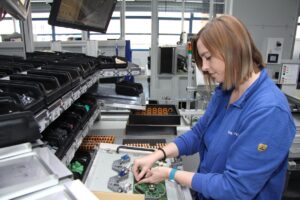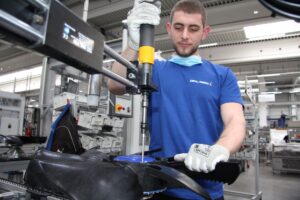Ziehl-Abegg reports record sales of 716 million euros
KÜNZELSAU, Germany, 31 March 2022: Ziehl-Abegg reported record sales of 716 million euros in 2021, compared to 639 million euros in 2020. Making the announcement through a Press release, the manufacturer of electric motors and fans said the figure posted in 2021 represented a growth of 11.9%.

The PCB manufacturing process at Ziehl-Abegg is an example of vertical integration at the company. Evelin Fazekas assembles a PCB for an EC motor
Peter Fenkl, CEO, Ziehl-Abegg, describing 2021, said, “In view of the problems with global supply chains, we took a cautious approach at times and, ultimately, managed to do pretty well in terms of sales.”
The company said it was equally heartening that the number of employees worldwide rose to 4,700, compared to 4,300 in 2020.
Fenkl described the earnings situation as “more than difficult”, as the supply chain problems not only had an impact on delivery times but on pricing, as well. “Some suppliers had already increased prices so quickly towards the end of 2020 and then repeatedly in 2021 that we were unable to pass these on to the market on a 1:1 basis,” he said.
Based on the experience in the first quarter, the manager knows that this situation will become more acute in the current year. “I’ve never experienced anything like this before,” Fenkl said. It is relevant to highlight that Fenkl has been at the helm of the family-owned business for more than 20 years.
Ziehl-Abegg said it is regarded as a company with a high level of vertical integration. “We now want to expand this even further,” Fenkl said. However, growth at the headquarters in Hohenlohe is problematical, as there is a serious shortage in the availability of the necessary additional workers there, the company said.
The intention, therefore, is to expand existing production facilities and establish new production sites, it added. Fenkl said: “Additional production sites will bring us closer to our customers.”

Thomas Späth assembles a fan at the Ziehl-Abegg production site in southern Germany
The company said the 11.9% growth in sales last year provides a good base for further growth. Ventilation systems were the sales driver in the year just past, contributing EUR 637 million to the overall result, the company said.
Fenkl said he held no illusions about the challenges that lie ahead. “Work shifts are currently being repeatedly cancelled because of a lack of components – how can you realistically plan and how are you supposed to satisfy your customers?” he said.
Ziehl-Abegg employs 2,600 people in Germany, 200 more than a year ago. The number of employees worldwide rose from 4,300 to 4,700. Since employees of the baby boom era in Germany are now increasingly reaching retirement age, this is having a direct impact on the available workforce potential. “Companies must, therefore, openly target Generation Z, the post-millennials,” Fenkl said. “We mustn’t persist with old ways of thinking but instead take the wishes and needs of young people seriously.”
ABB joins Eurovent
BRUSSELS, Belgium, ZÜRICH, Switzerland, 1 March 2022: Eurovent said ABB has joined as its newest Corresponding Member, adding that the Eurovent Board of Directors approved the membership of the manufacturer of HVACR drives, motors and controls during a meeting in February 2022.
According to Eurovent, ABB is one of the global manufacturers of drives, motors and controls for HVACR applications with a global footprint, supporting the industry across the world with products and services.
Frank Taaning Grundholm, Vice President of Global HVACR Sales, ABB, who also serves as a Board member of Eurovent and Eurovent Middle East, said: “To get the most out of an HVACR system requires smart planning, and the most critical focus for building operators is to move towards specifying needs rather than technical solutions only. We are excited to be part of Eurovent and look forward to taking even more active part in its dialogues that are guiding the development of HVACR products in a more sustainable direction and leading important advocacy for improved Indoor Air Quality.”
AMCA introduces tools to aid transition to Fan Energy Index
ARLINGTON HEIGHTS, Illinois, 2 August 2021: AMCA International introduced tools to aid transition to the Fan Energy Index. The body did so against the backdrop of recent developments related to energy efficiency in the United States.
On July 28, the US Department of Energy (DOE) issued determinations that the 2019 edition of ANSI/ASHRAE/IES 90.1, Energy Standard for Buildings Except Low-Rise Residential Buildings, and the 2021 edition of the International Energy Conservation Code (IECC) “will achieve greater energy efficiency in buildings subject to the code” and “will improve energy efficiency in residential buildings,” respectively. Upon publication of these affirmative determinations, the DOE said, states in the country must review and certify their building codes relative to ANSI/ASHRAE/IES 90.1-2019 and the 2021 IECC.
As states begin to examine and update their energy codes, some are adopting an earlier edition of ANSI/ASHRAE/IES 90.1 (2016 or 2013) or the IECC (2018 or 2015), AMCA said. In so doing, they are prolonging the use of fan efficiency grade (FEG) as the metric for efficiency provisions for commercial and industrial fans and blowers, AMCA said. FEG, which the DOE concluded in an as-yet-unfinished rulemaking is not an appropriate metric for a federal appliance/equipment regulation, was replaced by Fan Energy Index (FEI) for ANSI/ASHRAE/IES 90.1-2019 and the 2021 IECC, AMCA said, adding that it advises states adopting earlier editions of ANSI/ASHRAE/IES 90.1 and the IECC to “leapfrog” the outdated FEG metric to take advantage of the energy-saving, compliance-easing FEI.
For example, Florida, which on December 31 became the first state to adopt FEI when the seventh (2020) edition of Florida Building Code: Energy Conservation was published, adopted the 2018 IECC, but the 2021 IECC fan-efficiency provision, AMCA pointed out.
“Florida has set the example of how to leapfrog model-energy-code provisions to avoid prolonging the use of an outdated metric,” Aaron Gunzner, Senior Manager, Advocacy, AMCA International, said. “To help other states achieve the goal of phasing in the new FEI metric, AMCA International has, with permission from ASHRAE and the International Code Council, developed templates with exact strike-out/underline language.”
Additionally, to describe the rationale for and the benefits of changing metrics, AMCA said it recently updated its Advocacy Brief: New Fan Energy Index (FEI) Metric and Scope for Energy Codes, a document for code officials and others considering proposals to transition from FEG to FEI.
Formalized in ANSI/AMCA Standard 208-18, Calculation of the Fan Energy Index, FEI considers the effects of motors and drives, not just fans, and aids the right-sizing of fan systems for the conditions they will operate in, AMCA said. In addition to ANSI/ASHRAE/IES 90.1-2019 and the 2021 IECC, it added, FEI has replaced FEG in:
- 2021 International Green Construction Code (IgCC)
- ANSI/ASHRAE/ICC/USGBC/IES 189.1-2020, Standard for the Design of High-Performance Green Buildings Except Low-Rise Residential Buildings
AMCA recommended visiting www.amca.org/FEI, to download the templates and to view Advocacy Brief: New Fan Energy Index (FEI) Metric and Scope for Energy Codes. The microsite, AMCA said, additionally includes links to related codes and standards, technical articles and white papers, webinar recordings, and presentations.


